Top Dive, French Polynesia: Part IContents of this Issue: Top Dive, French Polynesia: Part I Touch Me Not! Leave the Dolphins Alone My Word, Itís Ugly Down There! Goodbye American Pioneer Diver Out-of-Practice, but I Want to Dive French Polynesia Dominica, Fiji, Belize, Costa Rica, Florida Advanced Danish POV Camera Finally Available Two Cameras to Start your Underwater Photographer Career Those Internet-Based Dive Travel Websites Harassing Animals and Coral to Attract Business Use the 24-Hour Rule to Your Advantage Donít Wash a Wound with Sea Water The Only Time You Should Hold Your Breath The Florida Shark Diving Saga Continues Finding Your Way Aided by a Compass A Bad Weekend At a Training Lake What Do You Have in Your Dive Bag? Editorial Office: Ben Davison Publisher and Editor Undercurrent 3020 Bridgeway, Suite 102 Sausalito, CA 94965 exciting diving for the experienced from the July, 2017 issue of Undercurrent
Dear Fellow Diver: The Zodiac motored slowly through the big swells of Rangiroa atoll's Tiputa Pass. When we reached the ocean, I back-rolled into the blue and followed the guide as he quickly descended to 130 feet, the deepest I had ever been. The visibility was stunning. I followed the guide toward the pass entrance, where row upon row of gray reef sharks rose from the ocean floor almost to the surface, seemingly perfectly spaced and in every row swimming in a separate direction: a wallpaper of sharks. The gentle current quickly increased until we were sucked through the channel, past bigeye jacks, barracuda, tuna, humphead wrasses and endless colorful reef fish. When we sought refuge in a cavern, I locked eyes with a great hammerhead shark passing just a few feet away. When the current finally relented, I was left gasping, breathing from my guide's octopus, my tank's supply nearly exhausted. This was 15 years ago on my first trip to Rangiroa. Would I feel the same excitement this trip?
Enclosing a lagoon 50 miles long and 20 miles wide, Rangiroa is French Polynesia's largest atoll and the world's third largest. It is about an hour's flight from Papeete. When we arrived in the morning, owner Alain drove us to his Pension Bounty, between the famed Tiputa pass and Top Dive's shop. He offers four comfortable ensuite units set in a garden near a beach, each with a kitchenette, a small deck, and hot water showers. That evening, we dined with Alain on his veranda, his only guests. He served fried prawns in a lemon butter sauce followed by grilled white fish fillets with oven-roasted potatoes, followed by a caramelized pineapple tart with vanilla ice cream. The conversation turned to his love of diving and how he and his wife decided to leave France for a new life in the tropics. Four times a day, one of Top Dive's two skiffs makes the five-minute jaunt to Tiputa Pass. Dives start in the ocean and proceed through the Pass only if tidal conditions allow. "We haven't been able to do this for several days," Yannik, the manager, told us. Because strong winds had been pushing water into the lagoon, failing to fuel an inbound current from the ocean, we could not cross the Pass and would have to complete our dive in the ocean. My disappointment, though, soon dissipated. Fish life along the wall was prolific, with schools of goatfish, bigeye jackfish, fusiliers, barracuda, humphead wrasses, and of course, sharks. During the safety stop, a turtle chomped at the coral while I looked out for a notorious striped triggerfish that had developed a taste for divers' ears. In the week I was there, three Top Dive customers were viciously assaulted and left scarred by painful bites to their ears. Although all following dives were at the same location, I had much to see, and in the balmy 83F (28įC) water, the fish were easily approachable. A three-foot great barracuda patiently waited for bluestreak cleaner wrasse to finish servicing its open mouth and gills. A moray eel slithered past on some urgent errand. A lonely remora followed me for much of a dive, perhaps hoping that I would adopt her. I especially enjoyed the sunset dives, when there was magic in the shimmering blue bands of the fusiliers. The main settlement of Avatoru, with its church, post office and pharmacy, is over six miles from Tiputa Pass, where Pension Bounty is located and the area where most divers choose to stay. We had lunch at the busy snack Chez Lily, an informal open-air restaurant near the main pier and one of only two snack on this side of the island. When the overworked waitress emerged with our meals after almost an hour, the $14 curried chicken was merely edible. The following day we biked to the market to buy a loin of frozen tuna, rice, and tinned vegetables to make our own meals. Fresh fruit is very expensive, available only briefly after a cargo boat arrives. I should note that English is widely spoken, though French and Tahitian are the local languages.
It was not until our fourth day in Rangiroa that the incoming current returned. My buddy and I were teamed with Vay, a cheerful and capable Tahitian guide, and an inexperienced couple. A school of barracuda hovered above, and dozens of gray reef sharks crisscrossed the bottom near the pass entrance. Soon, the current pulled me into the channel. I followed Vay into a valley for shelter and to watch the action. Vay had to reach up and grab the inexperienced woman diver, lest she disappeared into the lagoon. Her eyes bulged with fear as she grasped his arm for the rest of the dive. With all that shark action, I surfaced exhilarated, my tank still half full. I should note that twice we were teamed with rookie divers and had to ascend early. Given the cost of the diving, not to mention getting here, this is unacceptable for experienced divers.
Next, a flight to Fakarava, where we walked around the little village as we waited for the boat to our hotel. Hearing some commotion on the beach, I turned to see four large nurse sharks thrusting wildly by the shore. They had beached themselves trying to prize a couple of tuna carcasses left on the shore by a fisherman and struggled to get to deeper water, which they did, clutching their bounty. Fakarava, like Rangiroa, is a large atoll with only two ocean passes. Garuae, the northern pass, is near the main settlement where most visitors stay. Tomakohua, the southern pass, is two hours away by speedboat. Dive operators in the north sometimes offer day trips to Tomakohua if enough participants show and sea conditions permit it.
In daylight, after a steamy night battling the insects (don't forget your DEET!), I explored my surroundings. Motu Aito Paradise was on a barren motu, or reef islet. The pier entrance led through a long, scruffy workshop in a closed compound planted with nonnative trees. The outlook from our hut was through narrow windows, set below eye level, providing no view and little ventilation, perhaps not a bad thing as our hut overlooked the neighboring motu where Mannihi kept his pigs. There was nowhere to relax other than the bed or in the common area, which doubled as Mannihi's living room. While one should expect Spartan conditions in this remote setting, some consideration for travelers' needs would have made it more pleasant. "Paradise" was the last thing I would associate with Motu Aito. Later that day, an inflatable skiff brought us to a nearby motu and Top Dive's Fakarava South, with a compressor shack, dock, and Eric, who lived alone on the island for the past eight months with no internet or even radio; the boat showed when he had customers. With a shock of blond hair and blue eyes, and looking older than his 48 years, this veteran of French Polynesian diving previously ran a dive shop in Nuku Hiva, in the distant Marquesas. Logistical complications coinciding with our visit meant that he would be diving three times a day for at least three days in a row, and his obvious annoyance set the tone for our time with him. One could only wonder if he was tiring of his monastic life.
Breakfast at Motu Aito Paradise was always a piece of fruit, small pancakes, jams, tea or coffee. For dinner, spaghetti Bolognese was served two days in a row, and the same chopped lettuce and cabbage salad appeared every meal. Inexplicably for lodging priced at $300/ night for two, alcoholic beverages could not be had for love or money. One evening, when I resolved I would almost kill for a cold beer, I bribed Mannihi's cousin to give us a lift on his boat to the village. We were drenched in a squall, but at least we had cold beer to cheer us. A few sailboats crossing the Pacific moored in the lagoon. One evening Mannihi hosted a pizza dinner on the pier for their crew, who shared the wine they brought with them. Some, who were keen divers with compressors on their boats, related fascinating adventures of exploring remote unvisited reefs. One American who returns to Fakarava every year noted that in the lead-up to full moon every July, there is a massive aggregation of groupers, and for about 18 hours they spawn before dispersing into the ocean.
To depart, his cousin ferried us to a pension a distance away, where we were to wait for another boat to complete the journey. After depositing us with our bags on the pier, he turned back and disappeared. It was a long wait. After the deprivations of Motu Aito "Paradise," it was a relief to reach Pension Pearl Havaiki on the north side of Fakarava. More closely resembling a resort than a family pension, this property sits on a pretty beach of powder-white sand. Our garden unit was simply and elegantly appointed, cooled only with a ceiling fan. We could enjoy the sea views and breeze even though our unit was behind the air-conditioned beachfront units. Top Dive's Fakarava North operation could not have been more different than its southern affiliate. It was a smaller operation than in Rangiroa, but they had a powerful covered aluminum boat with well-designed ladders. And, they had Irene, a diminutive Tahitian lady who was supremely helpful, directing us to a place where we could buy fresh fruit and a wonderful and inexpensive hole-in-the-wall snack for lunch. She even arranged for Jonathan, one of the dive guides, to provide a lift to our pension, so we could have time to rinse and dry our gear after our last dive.
Was it worth crossing two oceans to come back here? Yes, indeed! Incredible and unique diving, odd experiences, in fact, a real adventure, one that I'll remember long after I forget those cushy resorts and liveaboards that most of us visit. And next month, I'll report on Bora Bora and Tikehau. --DTV Our Undercover Diver's Bio: Our Undercover Diver's Bio: DTV has been lucky to dive since 2001, mostly in the Indo-Pacific: Solomon Islands, Indonesia, Philippines, Palau, Chuuk, and the Maldives. He has also dived at the Cocos and Malpelo Islands, the Galapagos, French Polynesia, the Red Sea, the Mediterranean, the UK, and the Azores. He swam with humpback whales in Rurutu and with Orcas in Norway. He doesn't bother with a camera, preferring to capture memories in his mind's eye.
|

I want to get all the stories! Tell me how I can become an Undercurrent Online Member and get online access to all the articles of Undercurrent as well as thousands of first hand reports on dive operations world-wide
| Home | Online Members Area | My Account |
Login
|
Join
|
| Travel Index |
Dive Resort & Liveaboard Reviews
|
Featured Reports
|
Recent
Issues
|
Back Issues
|
|
Dive Gear
Index
|
Health/Safety Index
|
Environment & Misc.
Index
|
Seasonal Planner
|
Blogs
|
Free Articles
|
Book Picks
|
News
|
|
Special Offers
|
RSS
|
FAQ
|
About Us
|
Contact Us
|
Links
|
3020 Bridgeway, Ste 102, Sausalito, Ca 94965
All rights reserved.

 From Los
Angeles, it
takes eight-anda-
half hours to
fly nonstop to
Papeete, the
capital, about
three hours less
than a flight
to Fiji. After
landing late at
night, my partner
and I made
a hundred yards'
steep climb to
the Airport
Motel; the following morning, I booked a $19 cab for
one minute to carry my luggage down to
the airport.
From Los
Angeles, it
takes eight-anda-
half hours to
fly nonstop to
Papeete, the
capital, about
three hours less
than a flight
to Fiji. After
landing late at
night, my partner
and I made
a hundred yards'
steep climb to
the Airport
Motel; the following morning, I booked a $19 cab for
one minute to carry my luggage down to
the airport.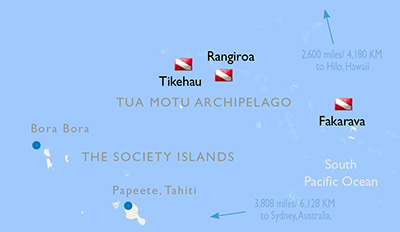 Travelers less attentive to a budget stay
next door to Pension Bounty at the upscale Kia Ora
Resort. It is the only hotel on the island with
overwater bungalows and its own sandy beach. On
their pier bar, I enjoyed the local Hinamo beer
($5.80), which came with marinated olives and
delicious fried chili coconut slices. A bowl of
stale bread induced fish feeding frenzies below
that sometimes attracted silkies or black tip reef
sharks. Skipping the touristy Polynesian buffet
show, I picked another night for dinner, where the
menu showed duck breast and rack of lamb at about
$28 each. A decent local white wine ran a pricey
$56 a bottle.
Travelers less attentive to a budget stay
next door to Pension Bounty at the upscale Kia Ora
Resort. It is the only hotel on the island with
overwater bungalows and its own sandy beach. On
their pier bar, I enjoyed the local Hinamo beer
($5.80), which came with marinated olives and
delicious fried chili coconut slices. A bowl of
stale bread induced fish feeding frenzies below
that sometimes attracted silkies or black tip reef
sharks. Skipping the touristy Polynesian buffet
show, I picked another night for dinner, where the
menu showed duck breast and rack of lamb at about
$28 each. A decent local white wine ran a pricey
$56 a bottle.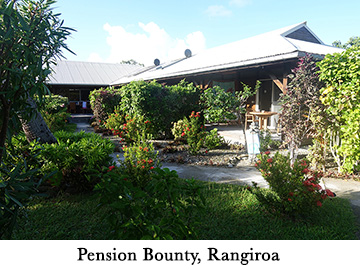 Top Dive provided 15l (105 cu ft) aluminum
tanks with nitrox 32. Their powerful twin-engine
sun-covered hard-bottom inflatable boats featured
well-designed ladders. Back at the dive shop, two
hot water outdoor showers got rid of the salt.
Top Dive provided 15l (105 cu ft) aluminum
tanks with nitrox 32. Their powerful twin-engine
sun-covered hard-bottom inflatable boats featured
well-designed ladders. Back at the dive shop, two
hot water outdoor showers got rid of the salt.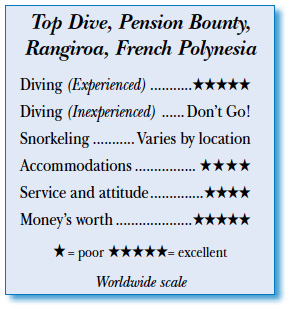 To assure ourselves dives in Tomakohua, we stayed first at Motu Aito Paradise,
one of two pensions nearby. It was a two-hour boat trip in a twin-engine covered
wooden boat, and dark when we arrived. Our host, Mannihi, a tall, handsome, mustachioed
man in his sixties, showed us to our large thatch-roofed hut with two
beds, dimly lit by two bare bulbs powered by solar panels, and no air conditioning. Our hut opened to an enclosed outdoor area
with an open-air shower and a doorless hut with a
toilet. With rainwater scarce, the shower and sink
taps required gripping the handle with one hand
to release a weak flow, a tedious process. And,
Mannihi said, emptying one's bladder was no excuse
for a toilet flush. Aside from Mannihi, his cousin,
and the cook who came on the boat with us, we were
the only people on the motu. My partner and I ate
our dinner in the common area, while Mannihi sat
nearby reading his newspaper.
To assure ourselves dives in Tomakohua, we stayed first at Motu Aito Paradise,
one of two pensions nearby. It was a two-hour boat trip in a twin-engine covered
wooden boat, and dark when we arrived. Our host, Mannihi, a tall, handsome, mustachioed
man in his sixties, showed us to our large thatch-roofed hut with two
beds, dimly lit by two bare bulbs powered by solar panels, and no air conditioning. Our hut opened to an enclosed outdoor area
with an open-air shower and a doorless hut with a
toilet. With rainwater scarce, the shower and sink
taps required gripping the handle with one hand
to release a weak flow, a tedious process. And,
Mannihi said, emptying one's bladder was no excuse
for a toilet flush. Aside from Mannihi, his cousin,
and the cook who came on the boat with us, we were
the only people on the motu. My partner and I ate
our dinner in the common area, while Mannihi sat
nearby reading his newspaper.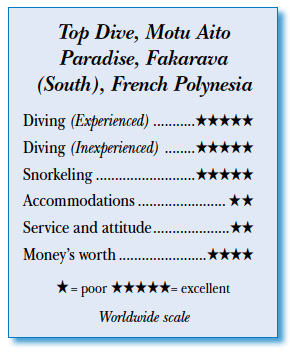 Once I went underwater,
I forgot about Eric's grumpiness.
I back-rolled into a
small school of unicorn fish,
and as I reached the bottom,
I came upon marbled groupers
by the thousands, looking like
an army of soldiers waiting to
attack. Eric led us into the
pass, where dozens of gray reef
sharks swam against the current
for some distance before
retreating and circling back
behind their peers. Many females
displayed the scars from aggressive
lovers. A few bulky 5-foot
(1.5m) blacktip sharks (not
blacktip reef sharks) hung
with the group. As the current
increased and I was pulled
deeper, the channel became shallower. It took some effort to avoid the
razor-sharp coral below and yet remain
clear of any boat traffic above. I eventually
surfaced a few yards from Top
Dive's dock. Another thrilling dive.
Once I went underwater,
I forgot about Eric's grumpiness.
I back-rolled into a
small school of unicorn fish,
and as I reached the bottom,
I came upon marbled groupers
by the thousands, looking like
an army of soldiers waiting to
attack. Eric led us into the
pass, where dozens of gray reef
sharks swam against the current
for some distance before
retreating and circling back
behind their peers. Many females
displayed the scars from aggressive
lovers. A few bulky 5-foot
(1.5m) blacktip sharks (not
blacktip reef sharks) hung
with the group. As the current
increased and I was pulled
deeper, the channel became shallower. It took some effort to avoid the
razor-sharp coral below and yet remain
clear of any boat traffic above. I eventually
surfaced a few yards from Top
Dive's dock. Another thrilling dive.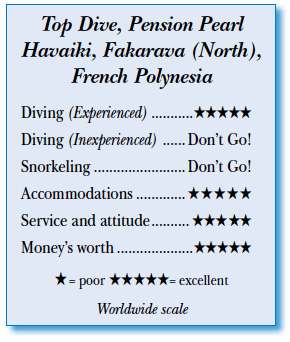 Even though Top Dive made little provision for Eric's own comfort, their shop
was outfitted with the latest membrane compressor, and all tanks were filled with
nitrox 36. The open inflatable skiff was adequate for the short rides. A simple
wooden ladder meant I could ascend without embarrassing myself. On most dives, we
were the only ones with him.
Even though Top Dive made little provision for Eric's own comfort, their shop
was outfitted with the latest membrane compressor, and all tanks were filled with
nitrox 36. The open inflatable skiff was adequate for the short rides. A simple
wooden ladder meant I could ascend without embarrassing myself. On most dives, we
were the only ones with him. Sebastian, a friendly Frenchman who had lived on the island with his Tahitian
wife for the last seven years, was assigned to us for our last day of diving.
After a 20-minute boat ride, we hooked to a buoy and I back-rolled into the blue.
Landing among a large school of goatfish, I followed Sebastian's example: hold on to dead coral in the strong current and watch the whitetips and gray reef sharks
patrol the pass entrance. After a few minutes, we let go, and I let the current
sweep me into the channel, keeping close to the bottom to control my speed.
Following Sebastian as he weaved his way through a series of canyons was tough,
with the current ripping in various directions. Overhangs hid schools of glasseyes.
In one rested a 9-foot (2.5m) nurse shark. Grey and whitetip reef sharks
swam among us. The patchy coral showed evidence of stress, with many sections
bleached or broken, with marauding crowns of thorn starfish common. The current
finally carried us into the lagoon, where Sebastian unclipped his sausage and we
ascended. The surge was rough, so I inflated my BCD, then noticed we were right
in the middle of the pass and our dive boat was 300 yards away, picking up other
divers. About a mile away, a cargo ship was headed directly at us. "We may have to
go back down to wait for it to pass," said Sebastian calmly. With my gauge indicating
300 PSI, I did not relish the prospect of descending on Sebastian's octopus.
Fortunately, our dive boat arrived, and the burly Polynesian porter assisted
in getting our gear out of the water while the captain tried to control the boat
as the waves tossed it about. Sebastian made it on board just before the ship
passed.
Sebastian, a friendly Frenchman who had lived on the island with his Tahitian
wife for the last seven years, was assigned to us for our last day of diving.
After a 20-minute boat ride, we hooked to a buoy and I back-rolled into the blue.
Landing among a large school of goatfish, I followed Sebastian's example: hold on to dead coral in the strong current and watch the whitetips and gray reef sharks
patrol the pass entrance. After a few minutes, we let go, and I let the current
sweep me into the channel, keeping close to the bottom to control my speed.
Following Sebastian as he weaved his way through a series of canyons was tough,
with the current ripping in various directions. Overhangs hid schools of glasseyes.
In one rested a 9-foot (2.5m) nurse shark. Grey and whitetip reef sharks
swam among us. The patchy coral showed evidence of stress, with many sections
bleached or broken, with marauding crowns of thorn starfish common. The current
finally carried us into the lagoon, where Sebastian unclipped his sausage and we
ascended. The surge was rough, so I inflated my BCD, then noticed we were right
in the middle of the pass and our dive boat was 300 yards away, picking up other
divers. About a mile away, a cargo ship was headed directly at us. "We may have to
go back down to wait for it to pass," said Sebastian calmly. With my gauge indicating
300 PSI, I did not relish the prospect of descending on Sebastian's octopus.
Fortunately, our dive boat arrived, and the burly Polynesian porter assisted
in getting our gear out of the water while the captain tried to control the boat
as the waves tossed it about. Sebastian made it on board just before the ship
passed.  Divers Compass: Air Tahiti Nui (American Airlines partner) and
Air France (Delta partner) serve Papeete from Los Angeles, with
fares starting at $1,232 r/t. Air Tahiti operates the interisland
flights (
Divers Compass: Air Tahiti Nui (American Airlines partner) and
Air France (Delta partner) serve Papeete from Los Angeles, with
fares starting at $1,232 r/t. Air Tahiti operates the interisland
flights (